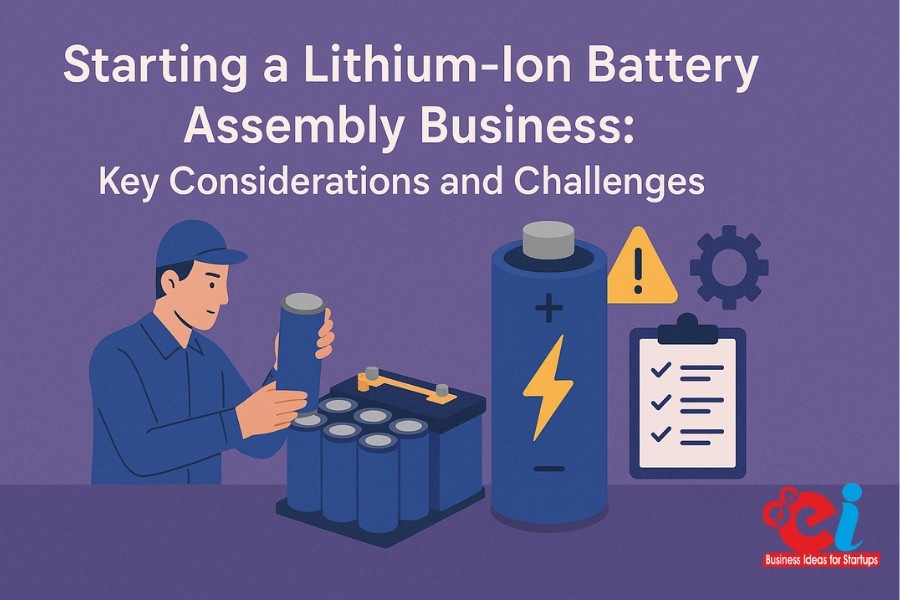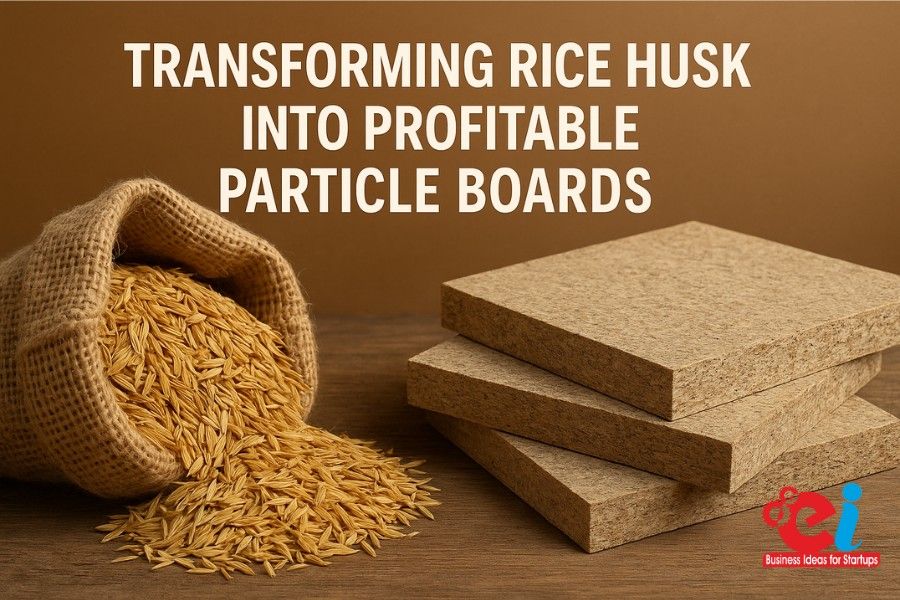With the advent of Electric Vehicles and the increased dependence on renewable resources, lithium-ion batteries are placed at the nexus of an energy revolution. EVs, smartphones, and even solar inverters capitalize on lithium-ion batteries and its demand is increasing worldwide.India has favorable policies and schemes like FAME – II, PLI schemes, and NEMMP which encourage the initiation of businesses related to electric mobility. Establishing a lithium ion battery assembly business in particular makes sense. Nevertheless, a sustainable business plan coupled with deep market insight and relevant technical knowledge is a prerequisite for entering the battery assembly segment.
In this guide, we will analyze the steps required to successfully establish a lithium ion battery assembly business. Along with the steps, we will shed light on the challenges one might face on the way.
1. Steps Involved in Lithium Ion Battery Assembly
Lithium ion battery assembly includes integrating BMS equipments into pre-manufactured cells that are formed into battery packs or modules. This includes:
- Arrangement of cells (series and parallel)
- Tab and terminal spot welding
- BMS Installation
- Encasement into protective shell
- Verification Testing
- Functional and Safety Testing
Unlike full-scale cell manufacturing, which requires significant investment, battery assembly is less capital intensive and better suited for growing startups specializing in:
- EV battery packs
- Solar energy storage
- E-bike and e-rickshaw batteries
- Industrial and telecom battery packs
2. Potential and Opportunities for Growth
The Indian Lithium Ion Battery Market is set to hit $25 billion by 2030. Growth is fueled by:
- Increased sales of EVs and adoption of e-mobility
- Solar microgrids and standby storage
- Government subsidies under FAME-II and the PLI Initiative for ACC batteries
Target Sectors:
- 2W/3W Electric Vehicles
- Solar Inverter Manufacturers
- Telecom and UPS Industry
- Portable Medical Devices
- OEMs of Consumer Electronics
3. Battery Assembly Business Strategies
Select the most appropriate business strategy depending on the level of funding, the scale of operations, and the available technical expertise:
| Model | Description |
| OEM Contract Assembly | Assemble batteries for other brands |
| Private Label/White Label | Distribute or sell packed batteries under different names |
| Custom Battery Pack Design | Design and assemble batteries for specific niche applications |
| EV Battery Retrofit | Upgrade or replace batteries in older vehicles |
Related: Strategic Insights for Initiating a Lithium-Ion Battery Production Unit
4. Choosing Cells for a Lithium-Ion Battery
Cell selection impacts performance, safety, and cost. Some well-known cell chemistries are:
| Chemistry | Use Case | Pros |
| NMC (LiNiMnCoO2) | EVs, Solar Storage | High energy density |
| LFP (LiFePO4) | E-rickshaws, Stationary Storage | High safety, long life |
| LCO (LiCoO2) | Consumer Electronics | Compact, moderate life |
Always obtain cells from certified vendors like LG, Samsung SDI, CATL, BYD and other approved Indian vendors.
5. Other Components Needed for Battery Assembly
Supporting parts for the construction of a lithium ion battery include:
- Cells (cylindrical, prismatic, or pouch) of Lithium ion batteries
- Battery Management System (BMS)
- Nickel strips and busbars
- Casing of batteries (Plastic, aluminum)
- Connectors, wires, insulators, fuses
- Stand for welding and in some cases tab welding
- Circuits for balancing and cooling systems if required
📌 NPCS NIIR Project Consultancy Services aids in the identification of domestic and international suppliers of components.
6. Requirements for Infrastructure and Machinery
Plant Setup:
- Area: 1000 – 3000 sq. ft. for small-medium scale
- 3-phase electricity and ESD protection
- Temperature and humidity control
Machinery Needed:
| Machine | Function |
| Spot Welding Machine | Welding of nickel strips to terminals |
| Battery Tester/Analyzer | Voltage, IR, charge-discharge test |
| BMS Installation Setup | Connect and calibrate BMS |
| Laser/Ultrasonic Welding | For pouch cells or precise welding |
| Battery Pack Aging System | Lifecycle simulation and testing |
| Thermal Shrink Packaging | Wraps battery in protective layer |
Total machinery cost: ₹20 – ₹40 Lakhs for medium scale setup
7. Licensing and Regulatory Compliance
Approvals and Standards:
- BIS Certification (IS 16046-2:2018) – mandatory for lithium ion battery packs
- WPC (for wireless BMS, if applicable)
- Pollution Control NOC (if soldering/chemical processes involved)
- Udyam/MSME Registration
- Fire and safety compliance
- GST Registration
- For EV battery applications, certification under AIS-156 and AIS-038 Rev 2 is required
📋 NPCS provides assistance in defining regulatory documentation and certification processes.
8. Battery Management System (BMS) Integration
A good BMS ensures:
- Overvoltage and Undervoltage Protection
- Thermal Management
- Current regulation and short-circuit protection
- State-of-charge (SoC) and state-of-health (SoH) monitoring
You can either:
- Purchase off-the-shelf BMS modules (low volume)
- Develop custom BMS with embedded firmware (scalable)
Always calibrate the BMS with the specific cell chemistry you’re using.
9. Safety Protocols and Testing Standards
Lithium-ion batteries are susceptible to thermal runaway if not properly managed.
Safety Testing Includes:
- Over-charge and over-discharge
- Crush test
- Fire/explosion resistance
- Aging and lifecycle testing
- Short circuit simulation
Adhere to standards:
- Transport safety UN 38.3
- International safety IEC 62133
- AIS-156 for EV batteries
Establish a quality control lab for batch testing in-house.
Related: Start Lithium-ion Battery Recycling Business
10. Workforce and Training Needs
Recruit trained professionals for the following roles:
| Role | Level |
| Electrical Engineer | Senior Roles |
| Technician/Operators | Mid-Level Roles |
| Welding, Testing, Packing | Mid-Level Roles |
| Quality Assurance Staff | Compliance Testing |
| Embedded Engineer | (Optional) BMS customization |
Train staff on ESD safety, cell handling, and precision welding.
11. Financial Investment and Viability
Cost Breakdown for a Project Capable of 100–200 Batteries a Day:
| Component | Estimated Cost (INR) |
| Machinery and Equipment | ₹20–40 Lakhs |
| Raw materials (cells, BMS) | ₹25–50 Lakhs (3-month stock) |
| Setup and Infrastructure | ₹10–15 Lakhs |
| Licensing and Certification | ₹5–7 Lakhs |
| Working Capital | ₹15–25 Lakhs |
| Total Investment | ₹75 Lakhs – ₹1.25 Crore |
Profit Margins:
- Avg Selling Price: ₹2500–5000 per pack depending on specs
- Gross Margin: 25–35%
- Break Even: 18–24 months
📊 NPCS provides complete DPR for cash flow statements, ROI analysis, and investor pitch decks.
12. Distribution and Marketing Strategy
Sales Channels:
- EV manufacturers (2W/3W/OEMs)
- Solar inverter dealers and EPC firms
- B2B e-commerce (IndiaMART, TradeIndia)
- Government tenders for rural energy storage
- Direct-to-consumer (e-bikes, startups)
Branding Tips:
- Emphasize “Make in India” and quality assurance
- Highlight safety, BMS features, and lifecycle
- Offer post-sale support and warranty (12–24 months)
13. Challenges in Battery Assembly Business
| Challenge | Mitigation |
| Cell Price Volatility | Lock long-term supplier contracts |
| Certification Delays | Work with experienced consultants |
| Competition from Imports | Focus on low-cost alternatives |
| Lack of R&D | Partner with engineering colleges |
| E-waste management obligations | Register under EPR Guidelines |
14. Government Incentives and Support
Eligible Schemes:
- PLI Scheme for ACC Battery Storage
- Startup India & MSME Subsidies
- PMEGP Scheme (credit-linked subsidies)
- Technology Upgradation Fund (TUFS)
- SIDBI Green Finance
Also Apply For:
- EPR Authorization (if packaging or recycling involved)
- APEDA or EPC registration (if exporting battery packs)
📑 NPCS provides assistance in applying for grants and preparing project documents.
15. Collaborating with NIIR Project Consultancy Services (NPCS)
NPCS offers comprehensive support for lithium-ion battery assembly projects including:
- Exhaustive Techno-Economic Feasibility Studies
- Machinery and Warehouse to Workshop Blueprint Design
- Equipment acquisition, placement, and operational commissioning
- Regulatory compliance and registration with the Bureau of Indian Standards
- Contracting and logistics management
- Developing investment models, strategies, and assistance with raising capital to meet project needs
Final Thoughts
Investing in a Lithium-Ion Battery Assembly business is an opportunity that presents itself during the transition to a more environmentally friendly healthcare system. It is essential to step into this market now due to the increasing prospects in e-mobility, solar energy, and energy storage.
Addressing the primary problems and incorporating NIIR Project Consultancy Services’ guidance with best practices shared here will aid entrepreneurs in establishing a legal, compliant, and profit-making battery enterprise.
One lithium cell at a time, position yourself toward the new frontier of possibility.

























